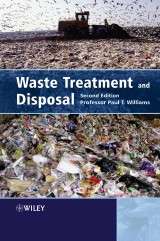Details

Waste Treatment and Disposal
2. Aufl.
|
68,99 € |
|
| Verlag: | Wiley |
| Format: | |
| Veröffentl.: | 13.12.2005 |
| ISBN/EAN: | 9780470026489 |
| Sprache: | englisch |
| Anzahl Seiten: | 424 |
DRM-geschütztes eBook, Sie benötigen z.B. Adobe Digital Editions und eine Adobe ID zum Lesen.
Beschreibungen
Following on from the successful first edition of <i>Waste Treatment & Disposal,</i> this second edition has been completely updated, and provides comprehensive coverage of waste process engineering and disposal methodologies. Concentrating on the range of technologies available for household and commercial waste, it also presents readers with relevant legislative background material as boxed features. <p>NEW to this edition:</p> <ul> <li>Increased coverage of re-use and recycling</li> <li>Updating of the usage of different waste treatment technologies</li> <li>Increased coverage of new and emerging technologies for waste treatment and disposal</li> <li>A broader global perspective with a focus on comparative international material on waste treatment uptake and waste management policies</li> </ul>
<p>Preface ix</p> <p><b>Chapter 1: Introduction 1</b></p> <p>1.1 History of Waste Treatment and Disposal 1</p> <p>1.2 European Union Waste Management Policy 5</p> <p>1.3 Waste Strategy of the European Union 8</p> <p>1.4 Policy Instruments 13</p> <p>1.5 EU Waste Management Legislation 15</p> <p>1.6 The Economics of Waste Management 38</p> <p>1.7 Options for Waste Treatment and Disposal 49</p> <p><b>Chapter 2: Waste 63</b></p> <p>2.1 Definitions of Waste 63</p> <p>2.2 Waste Arisings 66</p> <p>2.3 Municipal Solid Waste (MSW) 74</p> <p>2.4 Hazardous Waste 93</p> <p>2.5 Sewage Sludge 104</p> <p>2.6 Other Wastes 110</p> <p>2.7 Waste Containers, Collection Systems and Transport 119</p> <p><b>Chapter 3: Waste Recycling 127</b></p> <p>3.1 Introduction 127</p> <p>3.2 Waste Recycling 130</p> <p>3.3 Examples of Waste Recycling 143</p> <p>3.4 Economic Considerations 159</p> <p>3.5 Life Cycle Analysis of Materials Recycling 162</p> <p><b>Chapter 4: Waste Landfill 171</b></p> <p>4.1 Introduction 171</p> <p>4.2 EC Waste Landfill Directive 174</p> <p>4.3 Site Selection and Assessment 180</p> <p>4.4 Considerations for Landfills 181</p> <p>4.5 Types of Waste Landfilled 184</p> <p>4.6 Landfill Design and Engineering 185</p> <p>4.7 Landfill Liner Materials 187</p> <p>4.8 Landfill Liner Systems 192</p> <p>4.9 Processes Operating in Waste Landfills 197</p> <p>4.10 Other Landfill Design Types 207</p> <p>4.11 Landfill Gas 212</p> <p>4.12 Landfill Leachate 220</p> <p>4.13 Landfill Capping 227</p> <p>4.14 Landfill Site Completion and Restoration 227</p> <p>4.15 Energy Recovery from Landfill Gas 230</p> <p>4.16 Old Landfill Sites 236</p> <p><b>Chapter 5: Waste Incineration 245</b></p> <p>5.1 Introduction 245</p> <p>5.2 EC Waste Incineration Directive 248</p> <p>5.3 Incineration Systems 251</p> <p><b>Chapter 6: Other Waste Treatment Technologies: Pyrolysis, Gasification, Combined Pyrolysis–Gasification, </b><b>Composting, Anaerobic Digestion 325</b></p> <p>6.1 Introduction 325</p> <p>6.2 Pyrolysis 326</p> <p>6.3 Gasification 337</p> <p>6.4 Combined Pyrolysis–Gasification 342</p> <p>6.5 Composting 346</p> <p>6.6 Anaerobic Digestion 357</p> <p><b>Chapter 7: Integrated Waste Management 367</b></p> <p>7.1 Integrated Waste Management 367</p> <p>Index 375</p>
"...a readable and reliable source of information..." (Waste Planning, September 2005) <p>" … provides a useful and highly readable reference text." (<i>Journal of Applied Toxicology</i>: 26, 1: Jan/Feb 2006)</p> <p>"Gives a global perspective on national nanotechnology initiatives in Asia, Europe and the USA, investment opportunities and risks, and future applications of this technology." (<i>Materials World</i>, April 2006).</p>
<b>Paul T. Williams</b>, Professor of Environmental Engineering, The University of Leeds, UK.
Since publication of the first edition of <i>Waste Treatment and Disposal</i> , concern over waste and its disposal have increased and there have been many significant changes in the methods employed for waste treatment and disposal. In Europe, European Commission legislation is the major driver in solid waste management, which has an important impact on treatment technologies. <i>Waste Treatment and Disposal, Second Edition</i> has been completely revised and updated in line with new waste regulation, management and disposal methods, with an emphasis on European waste management legislation. <p><i>Waste Treatment and Disposal, Second Edition</i> covers all aspects of waste treatment and disposal, including legislation, technologies, processes, environment, sustainability and economics, and integration of the different waste treatment and disposal options. The theme of European legislation and its impact on the various waste treatment and disposal options, especially in relation to the environment, runs throughout this book.</p> <p>Completely revised and updated, new features include:</p> <ul> <li>A broad global perspective with a focus on comparative waste treatment uptake and waste management.</li> <li>Relevant legislative background material as boxed features.</li> <li>Increased coverage of re-use and recycling.</li> <li>Updated usage of different waste treatment technologies.</li> <li>Increased coverage of new and emerging technologies for waste treatment and disposal.</li> </ul> <p>Easy to read with clear and concise explanations, <i>Waste Management and Disposal, Second Edition</i> is essential reading for upper level undergraduates and Masters students taking courses on waste treatment and management in departments of Engineering, Civil Engineering, Environmental Science and Geography. It serves as an excellent up-to-date reference book on waste management for professionals in the waste treatment and disposal industry.</p>

















